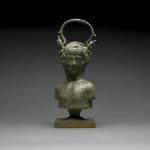Bust of Antinous Balsamarium, 100 CE - 150 CE
Bronze
height 22.9 cm
height 9 in
height 9 in
LA.571
Balsamarium, which can be translated as 'ointment or balsam container', is a modern functional term, more than a descriptive one, reflecting the purpose for which this relatively small vessel is...
Balsamarium, which can be translated as "ointment or balsam container", is a modern functional term, more than a descriptive one, reflecting the purpose for which this relatively small vessel is thought to have been used.
Its most common use was probably as a container for aromatic oils, though it is also suited for storing and dispensing cosmetic liquids and/or scented powdered substances. Balsamaria were carried to the baths filled with precious unguents and have often been discovered together with bronze strigils, a type of scrapers, further supporting the theory of their function as containers for aromatic oils, as applying oil and then scraping it off with a slightly curved blade-like strigil was a common practice of the bathing process. Balsamaria were produced in the first three centuries of the Roman Empire in a variety of forms, including busts and animal shapes.
Although a number of balsamaria or bronze oil vessels in the form of busts have survived to our days, few among these small portable objects bear resemblance to portraits that can still be identifiable today. The present balsamarium testifies to the power of imperial imagery and its dissemination across the vast Imperium, as the vessel portrays Antinous, Emperor Hadrian's lover. The general facial characteristics of our figure are consistent with the stylistic portrait features of the Late Antiquity and the personal features of Antinous, here appearing with large almond-shaped eyes, set into slightly upturned, incised pupils. Antinous was adored by Hadrian while in life and was deified after his untimely death drowning in the Nile. This deification led to an incredible proliferation of his portraits, often adopting the guise of youthful deities and rendered by the artists of the time with a particularly languorous beauty. During the last years of the reign of Hadrian, and probably for a certain time afterwards, a large number of such popular artefacts were produced throughout the empire, to meet an obvious demand.
Slight variations of the type occur as seen in the example in the Rheinisches Landes Museum in Bonn. Antinous is depicted wearing a nebris, or animal skin tied to the shoulder, another kind of draped garment, or as in our case, nude. Ivy or grapes may trail through his hair, yet he is above all depicted with a superior and striking beauty.
For further references see: Menzel, H. Die Romischen Bronzen aus Deutschland, III, Bonn, 1968.
Its most common use was probably as a container for aromatic oils, though it is also suited for storing and dispensing cosmetic liquids and/or scented powdered substances. Balsamaria were carried to the baths filled with precious unguents and have often been discovered together with bronze strigils, a type of scrapers, further supporting the theory of their function as containers for aromatic oils, as applying oil and then scraping it off with a slightly curved blade-like strigil was a common practice of the bathing process. Balsamaria were produced in the first three centuries of the Roman Empire in a variety of forms, including busts and animal shapes.
Although a number of balsamaria or bronze oil vessels in the form of busts have survived to our days, few among these small portable objects bear resemblance to portraits that can still be identifiable today. The present balsamarium testifies to the power of imperial imagery and its dissemination across the vast Imperium, as the vessel portrays Antinous, Emperor Hadrian's lover. The general facial characteristics of our figure are consistent with the stylistic portrait features of the Late Antiquity and the personal features of Antinous, here appearing with large almond-shaped eyes, set into slightly upturned, incised pupils. Antinous was adored by Hadrian while in life and was deified after his untimely death drowning in the Nile. This deification led to an incredible proliferation of his portraits, often adopting the guise of youthful deities and rendered by the artists of the time with a particularly languorous beauty. During the last years of the reign of Hadrian, and probably for a certain time afterwards, a large number of such popular artefacts were produced throughout the empire, to meet an obvious demand.
Slight variations of the type occur as seen in the example in the Rheinisches Landes Museum in Bonn. Antinous is depicted wearing a nebris, or animal skin tied to the shoulder, another kind of draped garment, or as in our case, nude. Ivy or grapes may trail through his hair, yet he is above all depicted with a superior and striking beauty.
For further references see: Menzel, H. Die Romischen Bronzen aus Deutschland, III, Bonn, 1968.



